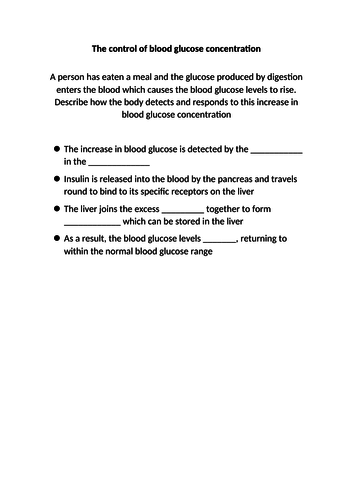


This engaging lesson guides students through the homeostatic control mechanism which is involved in controlling blood glucose concentrations and focuses on the critical interconversion between glucose and glycogen which is often poorly understood. The lesson begins by introducing glucose and ensuring that students recognise that this is a simple sugar which is critical for respiration. Links are made here and throughout the lesson to relateable topics such as the endocrine system so that students can recognise how exam questions will often encompass more than one topic. Students are challenged to recall knowledge about the pancreas and its release of insulin into the blood to travel to the liver. A quick competition is then used to maintain engagement and to introduce glycogen. Due to the large number of words beginning with g that are involved in this topic, time is taken to describe the role of glycogen so that it is not mistaken for glucose or glucagon. Students will learn how the conversion from glucose to glycogen and also the other way round is critical to how the concentration is controlled. The main student tasks involve them completing a partially finished passage about responding to an increase in blood glucose concentration and then using this as a guide to write their own full versions for when concentrations are low. These are just two of a number of progress checks that are written into the lesson at regular intervals so that students can constantly assess their understanding.
This lesson has been written for GCSE students (14 - 16 year olds in the UK) but could be used for A-level lessons that are recapping on this topic before extra knowledge is added at this higher level
Get this resource as part of a bundle and save up to 33%
A bundle is a package of resources grouped together to teach a particular topic, or a series of lessons, in one place.
Topic B3: Organism-level systems (OCR Gateway A GCSE Biology)
This bundle of 15 lessons covers the majority of the content in Topic B3 (Organism level systems) of the OCR Gateway A GCSE Biology specification. The topics covered within these lessons include: The nervous system The eye Hormones and the endocrine system Adrenaline Negative feedback loops Thyroid gland and thyroxine The menstrual cycle Contraception Using hormones to treat infertility Plant hormones Homeostasis Controlling body temperature Controlling blood glucose Diabetes Inside the kidney All of these lesson presentations and accompanying resources are detailed and engaging and contain regular progress checks to allow the students to constantly assess their understanding.
Topic B3: Organism level systems (OCR Gateway A GCSE Combined Science)
This bundle of 11 lessons covers the majority of the content in Topic B3 (Organism level systems) of the OCR Gateway A GCSE Combined Science specification. The topics covered within these lessons include: The nervous system Hormones and the endocrine system Adrenaline Negative feedback loops Thyroid gland and thyroxine The menstrual cycle Contraception Using hormones to treat infertility Homeostasis Controlling blood glucose Diabetes All of these lesson presentations and accompanying resources are detailed and engaging and contain regular progress checks to allow the students to constantly assess their understanding.
Topic B9: Coordination and response (Cambridge iGCSE Science Double Award)
This bundle of 9 lessons covers the majority of the content in Topic B9 (Coordination and response) of the core and supplement sections of the Cambridge iGCSE Science Double Award specification. The topics and specification points covered within these lessons include: The parts of the nervous system - CNS and PNS Identifiying sensory and motor neurones from diagrams The coordination of regulation of body functions Identifying the structures of the eye The functions of the parts of the eye Hormones as chemicals produced by glands The actions of adrenaline Homeostasis as the maintenance of a constant internal environment Control by negative feedback The control of blood glucose by the liver and insulin and glucagon from the pancreas The maintenance of a constant internal body temperature Phototropism, gravitropism and the involvement of auxins All of these lesson presentations and accompanying resources are detailed and engaging and contain regular progress checks to allow the students to constantly assess their understanding
Topic B3.3: Maintaining internal environments (OCR Gateway A GCSE Combined Science)
This bundle of 3 lessons covers all of the content in the sub-topic B3.3 (Maintaining internal environments) of the OCR Gateway A GCSE Combined Science specification. The topics covered within these lessons include: The importance of maintaining a constant internal environment in response to internal and external change Explain how insulin controls blood sugar levels Explain how glucagon controls blood sugar levels Compare type I and II diabetes All of these lesson presentations and accompanying resources are detailed and engaging and contain regular progress checks to allow the students to constantly assess their understanding.
Topic B3.3: Maintaining internal environments (OCR Gateway A GCSE Biology)
This bundle of 4 lessons covers the majority of the content in the sub-topic B3.3 (Maintaining internal environments) of the OCR Gateway A GCSE Biology specification. The topics covered within these lessons include: Controlling body temperature Controlling blood sugar Diabetes type I and II Inside the kidney All of these lesson presentations and accompanying resources are detailed and engaging and contain regular progress checks to allow the students to constantly assess their understanding.
Something went wrong, please try again later.
This resource hasn't been reviewed yet
To ensure quality for our reviews, only customers who have purchased this resource can review it
Report this resourceto let us know if it violates our terms and conditions.
Our customer service team will review your report and will be in touch.